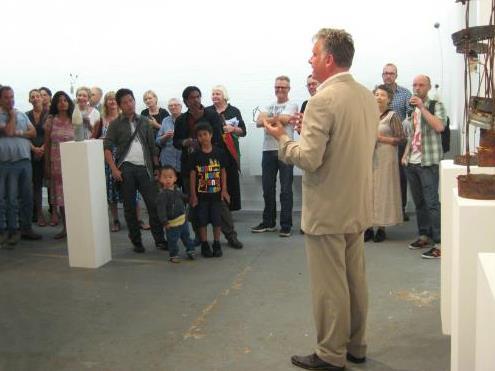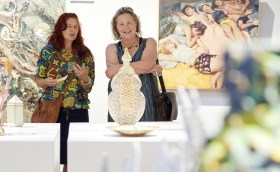Image: Damien Minton
Galleries open and galleries close. There is nothing new in that. In the last 12-24 months, however, the Sydney gallery landscape has been going through a reshuffling of sorts, as the ‘hip heat’ of Redfern cools and the pendulum swings back to Paddington. Why? ArtsHub posed that question to several Sydney dealers with interesting results.
Christopher Hodges, of Utopia Art Sydney and a long-term tenant of the Danks Street Waterloo gallery complex, felt that the so-called hype and spike of the Redfern-Waterloo precinct had not hit a wall.
Hodges said, ‘Definitely not, the negative sentiment in the economy just stopped retail sales across the board and if you walk down Oxford Street you will see the effect there too.’
Hodges described the gallery landscape as, ‘Tight but improving.’ He added, ‘Collectors are still out there and still looking for unique quality work, and you can only find that in art galleries.’
‘Certain sectors are thriving, others are in flux,’ said Damien Minton, of Damien Minton Gallery, also in the Redfern precinct.
Last year the Damien Minton Gallery moved from its Great Buckingham Street home, around the corner to Elizabeth Street, a space more suited to experimental projects, pop up events and, arguably, a better space for showing work, competing less with the industrial architecture of its former site.
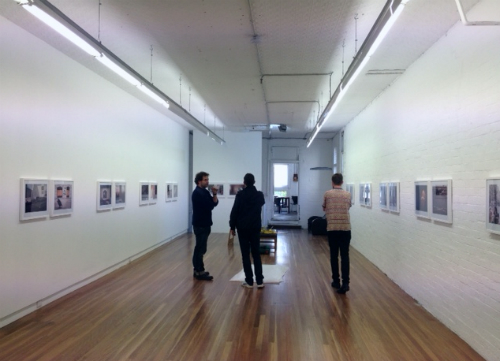
The new Damien Minton Gallery on Elizabeth Street, Redfern
While the decision was partly economic, for Minton the move reflected other shifts: ‘The commercial gallery system is trying to find new footing in the digital age which has eroded mid 20th century models and patterns of engaging audiences.‘
Minton added: ‘Traditionally it was relatively easy to visit a half a dozen galleries on a Saturday afternoon, the selection of what to see was a combination of word of mouth and critic review. This is no longer the case, so in order to justify the need for bricks and mortar other marketing strategies are essential.’
Shared by dealer Dominik Mersch (pictured below), who relocated his gallery from Danks Street to Rushcutter’s Bay this month, this view of flexibility and expanding the way galleries engage with audiences is key to the future of his new space.
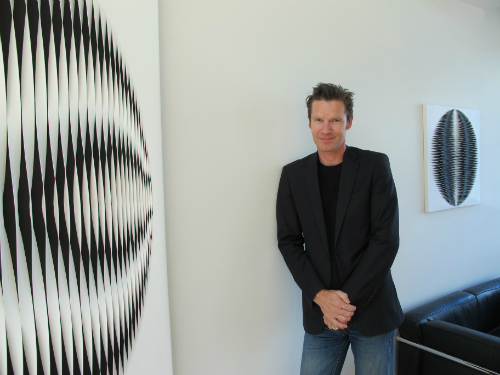
Mersch said: ‘To get people into the gallery you have to offer more and one thing is doing events, talks and discussion, and the other is doing unconventional stuff and I personally love it! I just want to play around a little bit as well, and with space I can do that. I want to call it “the lab” and even do music DJ sets and cinema.’
He added, ‘It is absolutely essential to have a gallery. I strongly believe in the gallery space.’
Minton said: ‘Visitation and engagement in art is on line, on one’s lap or sofa. Yet purchasing is still predominately done in the flesh surrounded by bricks and mortar. So the challenge is to add value and reason for people to come and physically make that effort.’
Hodges, however, disagrees with the event-adding path. He said, ‘I am totally over pop ups and entertainment driven art events, pretending to be art. An artist works in isolation and when they bring their art to the world they want it to be considered, not a backdrop for a night out.’
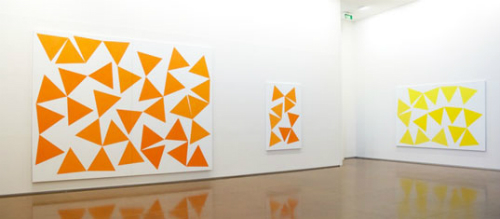
Helen Eager exhibition at Utopia Art Sydney
Hodges added: ‘Doesn’t mean we don’t hold talks and openings, but artists need an audience who appreciates their art, and occasionally buys it, to survive.’
New Zealand dealer Andrew Jensen, who set up a space in Paddington in 2011 and is currently expanding to two new spaces due to open end of November, epitomizes that position.
He has been reported saying, ‘The art fair model has stripped some of the most vital dimensions away that exhibitions in gallery spaces offer to both audience and artists. A slower digestion and more informed mediation of work ought to happen in galleries away from the froth and pressure of a trade fair.’
By separating how we engage with art; one space for exhibitions that is not compromised by other activities, and another, a private space to work with collectors – contemplation and commercial – Jensen advocates in educating audiences in that difference, returning them to a more traditional gallery experience.
The polarizing of galleries, then, is not merely geography.
Jenson moves into a tight Paddington gulch of galleries that includes Australian Galleries and Roslyn Oxley9, veterans to the area, and more recent additions Martin Browne Contemporary and Sarah Cottier Gallery, making this a quality one-stop art destination.
Danks Street has had that similar appeal of the one-stop-shop, and one could argue still does. It clusters Utopia Art Sydney, Janet Clayton Gallery, Brenda May Gallery, Stella Downer Fine Art, Annette Larkin, Aboriginal and Pacific Art Gallery, Syndicate, and the Depot rental spaces. All eyes are on who will fill the recently vacated Dominik Mersch Gallery space.
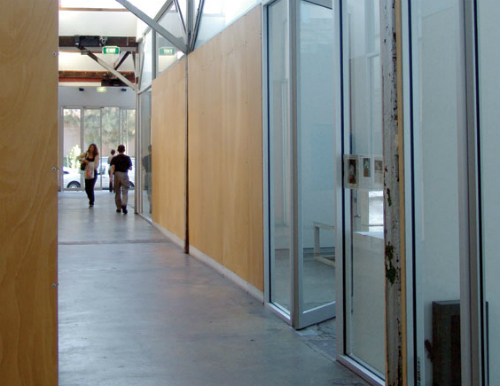
Danks Street gallery complex in Waterloo, Sydney
Hodges said: ‘The benefit of Danks Street is we get a lot more people simply having a look at eight galleries rather than one and when you have a problem you have eight colleagues at hand. Its good for students, curators, designers and consultants and people wanting to learn about art.’
There is, however, a more immediate shift at play with the Danks Street area that has nothing to do with the visual arts scene. Pressures of parking, an implosion of boutique Design shops, cafes, apartments and a colonising by the Hillsong church have changed the character of the neighbourhood.
Mersch said, ‘The street has really changed; parking is an issue and it is becoming more residential and the edge is a little bit gone. It is a shame in a way.’
It is the age-old story of artist-lead gentrification.
Minton said, ‘A decade ago the Paddington belt of galleries were seen as staid and of another generation and therefore there was a desire to be located in the developing gentrification of ‘fringe’ inner city suburbs. It echoed the pattern of other cosmopolitan cities around the world, cheaper more exciting spaces were found on the fringe.’
Minton continued, ‘Yet with the new paradigm being so heavily dictated by the neo liberal merchant class there is a swing back by contemporary commercial galleries to the Sydney eastern suburbs. It is safe, easy to access, less time consuming and cosy when the decision making is done in your own backyard.’
So does that mean, that the experimental will stay at the gritty edges and top drawer collectors swing their BMWs back to Paddo?
Mersch remains confident it is just a pendulum swing, and new tenants will revitalise the area. He added, ‘I wish them best of luck; for me it was great to start. It’s always a courageous move; my last expansion was just when the GFC started, and everybody said “are you crazy”. I was there six and half years. I am again doubling my space.’
Clearly this landscape remains a small and close footprint; Mersch’s inaugural exhibition in his new space is the work of Marion Borgelt, partner of the Danks Street Complex developer.
One can’t hardly wright off what has been achieved in Redfern-Zetland-Everleigh in recent years. Darren Knight was the first and remains strong today at Waterloo. Galleries such as Sullivan + Strumpf and Anna Schwartz Gallery at Carriageworks are defining Sydney’s art scene at the highest professional level.
What it perhaps best indicates is that in the climate of today’s mobility, ‘where’ is less an issue than what. It is the quality of the gallery and its program that draws audiences.
